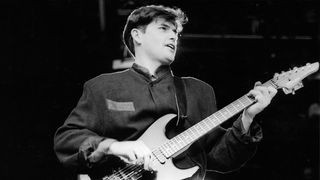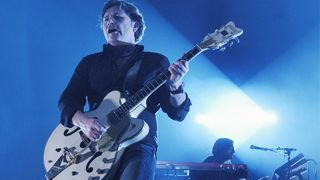Charlie Burchill is the sonic architect behind Simple Minds, the Glasgow band that ascended to stadium rock royalty in the 1980s. As Simple Minds release their 18th album, Direction Of The Heart, Burchill reflects on his evolving guitar journey, from unconventional beginnings to sonic experimentation, and his enduring love affair with guitars.
Humble Beginnings
Burchill’s entry into the world of guitar was as unique as his playing style. “My very first guitar, my mother got me when I was maybe nine,” he recalls. “It’s a true story – she bought me this guitar with coupons from Embassy cigarette packets!” His serious playing began around age 12, inspired by his older brother’s abandoned instrument. “He fancied playing guitar and bought a semi-decent one that I eventually nicked off him. He gave up and I carried on.” This serendipitous start laid the foundation for a remarkable career as a distinctive guitar player.
Glasgow Roots and the Punk Doorway
The burgeoning punk scene in Glasgow during the late 1970s provided the perfect launchpad for Burchill and Simple Minds. “Jim [Kerr] and I, we joined Johnny and the Self Abusers in 1977,” Burchill explains. “The punk scene was flourishing in Glasgow and it created so many opportunities for everybody.” While their musical tastes leaned towards bands like The Doors, Velvet Underground, and Roxy Music, punk offered accessibility and a sense of possibility. “Even if you weren’t proficient, you could believe that you could actually play in a band,” he notes. Following Johnny and the Self Abusers’ disbandment, Burchill and Kerr formed Simple Minds, embarking on a journey to carve their unique sound.
Early Simple Minds Guitar Rig: Simplicity and Experimentation
In the early days of Simple Minds, Burchill’s guitar setup was far from elaborate. “My early Simple Minds rig was really simple. I was using a transistor Carlsbro – there wasn’t a great deal of stuff going on,” he admits. However, even then, a crucial element of his signature sound was present: delay. “But I always had the delay – that was really important.” As the band progressed, experimentation became key. “We hooked up with a guy who worked with us for years, and he was a technical wizard who used to put together pedalboards for me with all sorts of different variations. We would just experiment. It was all a bit makeshift, but it got us to where we wanted to be.” This DIY approach and focus on effects became integral to his evolving guitar style.
The Allure of the White Falcon
A pivotal moment in Burchill’s guitar journey was his discovery of the Gretsch White Falcon. “I never knew much about Gretsch, but in the early ’80s, we started playing America and I came across the White Falcon,” he recounts. The initial attraction was purely aesthetic: “It’s such a beautiful guitar, that was the original attraction.” Beyond its looks, the White Falcon resonated with Burchill’s playing style. “The White Falcon is not the easiest to play, but I realised that Gretsch is something that suited me because it speaks really well, no matter how distorted it is.” He became a devoted Gretsch enthusiast. “Now I collect Gretsches and I’ve got a couple I still use today. But it’s crazy to think that in 1982, White Falcons were $600…” The quality of vintage Gretsches further solidified his appreciation. “With the older ones, you can hear how good they sound without even plugging in, and if it’s good from the source then it’s going to be good when it’s amplified.”
 Charlie Burchill
Charlie Burchill
Charlie Burchill performing on stage in Cardiff in August 1989, shortly after the release of Street Fighting Years.
Rejecting Convention: Sound & Vision Beyond Powerchords
Burchill’s approach to guitar playing has always defied conventional rock tropes. “I hated the straightforward guitar stuff. I never liked the idea of powerchords and just giving the song a bit of body,” he states emphatically. His musical influences steered him away from mainstream rock. “I was never a big fan of AOR American rock stuff. I was coming from a slightly more psychedelic background.” He cites Robby Krieger of The Doors as an example of a guitarist who transcends simple categorization. “Somebody like Robby Krieger in The Doors, he can play blues and he’s playing what you could say is ‘conventional’ guitar, but when you go a bit deeper, you realise it’s quite out-there, actually, and probably coming more from a slightly jazz background.”
Technology played a crucial role in shaping Burchill’s unique sound. “Technology changed the game massively for guitar players. Suddenly, from being a guitar and an amp, three chords and the truth, you could go into a different realm completely.” Effects pedals opened up new sonic territories for him. “And as soon as I found effects, that’s where I was going.” This embrace of effects became a hallmark of the Simple Minds’ sound and Burchill’s guitar work.
Gradual Ascent and Defining Moments
Simple Minds’ rise to fame was a gradual process punctuated by key moments. “Being on The Old Grey Whistle Test in 1979 was pretty daunting because it was a serious music programme, but it felt like we had arrived somewhere, finally,” Burchill reflects. Despite their early performance being “dreadful” in hindsight, it marked a significant step. “It was very gradual, our success,” he reiterates. “We did have moments when it jumped a few levels, but by and large, it was always a work in progress.” The camaraderie within the band and solid management were crucial during this period. “We were great mates and for the first part of the ’80s we were really enjoying the travelling and being out of Glasgow. We had a great manager at the time, Bruce Findlay, who was like this father figure, making sure you kept your feet on the ground and didn’t get [egotistical].”
Taking Risks: Double Albums and Creative Freedom
A critical juncture for Simple Minds was their transition to Virgin Records. “In the early ’80s, Arista [Records] were gonna drop us and we thought, ‘Okay, this is where it gets really tough.’ But we had a friend at Virgin who was pushing to get Branson to sign us.” This change led to a period of bold experimentation. “The first thing we gave them was Sons and Fascination/Sister Feelings Call [1981], which was a double album – which was at that time anathema to everybody. Not only that, it was quite abstract.” Virgin’s openness to their artistic vision was liberating. Their collaboration with Steve Hillage, known for his progressive rock background, was particularly unconventional. “They suggested we work with Steve Hillage, which was really out of the box because Steve was the prog guy from Gong and his own records. So we were thinking, ‘How is that going to work?’ But it was brilliant, actually, and it allowed us so much freedom.” This experimental phase shaped their unique sound and demonstrated their willingness to defy industry norms. “We never, ever stuck to the formula. And you could do that in those days. You couldn’t do it now.”
Les Paul Encounters and Vintage Appreciation
Burchill’s first live concert experience, Led Zeppelin, ignited a desire for a Gibson Les Paul. “The first band I ever saw play live was Led Zeppelin, so I had to get a Les Paul.” Despite initial financial constraints and attempts to build his own, he eventually acquired a Les Paul copy. His knowledge of Les Pauls developed over time. “But the thing was, I didn’t really know much about Les Pauls, in terms of the different years and what makes them good or bad. And it’s very subjective because, actually, I quite like a lot of the heavier Les Pauls from the early ’70s, which a lot of people don’t like.” He still uses a ’70s Les Paul live and appreciates the nuances of vintage instruments. “But I play one live, which is an early ’70s and I love it. Just a brilliant sound.” He acknowledges the allure of iconic vintage guitars. “A friend of mine bought a ’59 in mint condition. The closest I’ve got to that was two of those Gibson ’59 True Historic reissues. They’re really great – I can only imagine what a real ’59 is like.”
 Charlie Burchill
Charlie Burchill
Charlie Burchill performing live, showcasing his enduring passion for guitar.
The Vintage Guitar Obsession
Burchill’s appreciation for vintage guitars extends beyond Les Pauls. “I’ve got a lot of old Fenders, and the difference between a ’50s Telecaster and something from the ’70s is astronomical,” he observes. He highlights the unique character of older instruments. “Years ago, I brought a ’55 Gretsch Duo Jet and when you pick it up, it’s really light; it feels like something not that substantial, but it’s just incredible.” He expresses a preference for vintage guitars over modern counterparts. “For me, I don’t understand why people would buy new guitars when they could pick up a ’60s Gretsch for the same money. It’s mad.” However, he acknowledges the escalating prices in the vintage market. “Recently, like everything else, guitars have just got ridiculous, the vintage thing has got ridiculous. They’ve gone up at least 30 per cent for no reason.” Despite the rising costs, he still finds value in vintage finds. “But y’know, I bought a ’65 Country Gent for 1,500 quid and it’s a fantastic guitar. And recently, I got a ’62 Jaguar; it was refinished and, of course, that means the value’s not there, but it’s an amazing guitar.”
“Don’t You (Forget About Me)”: An Unexpected Hit
The story behind Simple Minds’ biggest hit, “Don’t You (Forget About Me),” is one of serendipity and initial reluctance. “We didn’t write Don’t You (Forget About Me),” Burchill clarifies. The record company pushed for the song, despite the band’s initial reservations. “The thing was, the record company had been on our back for a long time to do this song. It wasn’t that we didn’t like it. It was just that, at the time, we’d just written an album [1985’s Once Upon A Time], we were going to work with Jimmy Iovine and we felt that we had real songs there.” The song’s association with The Breakfast Club movie further distanced them initially. “It was going to be in The Breakfast Club – a movie about American high school kids and detention, which we couldn’t relate to. So we had a bit of an attitude about it.” However, meeting songwriter Keith Forsey changed their perspective. “But then we met the guy who wrote it, Keith Forsey, and absolutely loved him. We just went with it, rattled the song out in an afternoon – and there you go, Murphy’s law.” The song’s massive success became a defining moment for Simple Minds, despite its unconventional origins within their discography.
U2 and the Edge’s Sound: Gear Envy and Inspiration
During the 1980s, Simple Minds were often compared to U2, despite stylistic differences. “When you look back, the ’80s were so diverse. There was a period when we were always being lumped into a box with U2, even though we don’t sound anything like each other.” Burchill developed a friendship with U2 and was particularly impressed by The Edge’s guitar sound. “We first met those guys in the ’70s and we became great friends immediately. I remember, in the mid-’80s, I was in the studio in Ireland with U2, and Edge had his Vox AC30, his delays and his black Strat in there. I said to him, ‘Give us a shot!’ I picked up his Strat – and I sounded like Edge! By the way, it was the best fucking guitar sound I’ve ever heard. It just sounded unbelievable. I remember thinking, ‘Jesus, it’s in the gear as well…’” This experience highlighted the importance of gear in shaping a guitarist’s signature tone.
Street Fighting Years: Experimentation and Collaboration
Street Fighting Years marked a period of significant artistic exploration for Simple Minds. “Street Fighting Years [1989] was an interesting album. We loved the records that Trevor Horn and Stephen Lipson were making, and they wanted to work with a bona fide band. Trevor’s quite adventurous, so we set up a studio in a house in the Scottish Highlands and things would just happen.” Collaborations became a defining feature of the album, including the unexpected addition of Lou Reed on “This Is Your Land.” “For example, with the track This Is Your Land, Jim said, ‘Wouldn’t it sound great if Lou Reed sang on that?’ And Trevor and Steve would say, ‘Well, let’s see if he’s up for it!’ And he did it.” The album also included a cover of a traditional Celtic song, “Belfast Child,” and Peter Gabriel’s “Biko.” “Then Trevor said, ‘You should do an old traditional Celtic song.’ We were thinking, ‘Really? That’s too obvious,’ but as it turns out, that’s how Belfast Child came out. We had toured with Peter Gabriel so we did his song Biko.” The album featured diverse musical contributions. “We were working with different musicians like Stewart Copeland and Manu Katché. Before we knew it, we had this album that had great big moments… and then there’s other parts where we just felt like we had missed, we never quite got it.” Despite their own mixed feelings, Street Fighting Years remains a favorite for many fans, showcasing Simple Minds’ willingness to push creative boundaries.
Embracing the SG: A New Guitar Chapter
After years of favoring other guitar models, Burchill rediscovered the Gibson SG. “There were a few guitar players I love that play SGs, but I never got on well with them myself. I always found the balance too weird.” However, recognizing the SG’s distinctive sound in the music of artists he admired led to a change of heart. “But I started hearing this thing on records that I recognised as an SG sound and I realised there were a few things we were doing where that’s the guitar I should have been using. Like Alice Cooper’s early bands, or Zal Cleminson from The Sensational Alex Harvey Band, even Sister Rosetta Tharpe – you listen to her clipped playing and you think, ‘That’s an SG.’” He acquired a vintage SG. “So about four years ago, I bought a 1962 white SG with the three pickups and the standard Vibrola, not the sideways one. And the sound of that guitar is just completely different – it’s got a bite to it that you don’t get with a Les Paul. It’s got an attack. And there’s something about the three-pickup [format].” The SG’s unique design and tonal qualities have influenced his playing. “It’s quite weird when you’re playing it – because you’ve not got that space for your right hand because the pickups are there, so you play differently.” He has now integrated the SG into Simple Minds’ live performances. “Funnily enough, I just decided last week that I was going to use the SG a lot more in our live set.”
Direction of the Heart: A Continual Evolution
With their latest album, Direction of the Heart, Simple Minds continue to evolve. “With the new Simple Minds album, Direction of the Heart, we worked on about 25 songs and didn’t really know what kind of record we were making,” Burchill explains. The focus was on capturing the essence of Simple Minds’ sound. “It was more about making sure the tracks cover all the things we find important, like energy, melodies and that it’s going to work live.” The album explores new sonic territories while retaining the band’s core identity. “There are a few things that are slightly different territory for us and a bit more playful. We just said, ‘Well, this feels good, and we’ll learn about it as we go on.’” Burchill reflects on the dynamic relationship between artists and their creations. “You make a record and then you find out what you’ve made a year or two later. It sounds trite, but there’s a point where it doesn’t belong to you any more. When it’s gone out and people have listened to it, then it’s their record – it’s kind of got nothing to do with us any more.” This perspective underscores the enduring journey of Simple Minds and Charlie Burchill’s ever-evolving guitar artistry.


